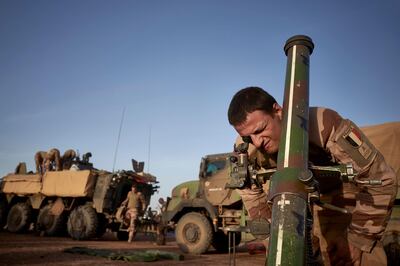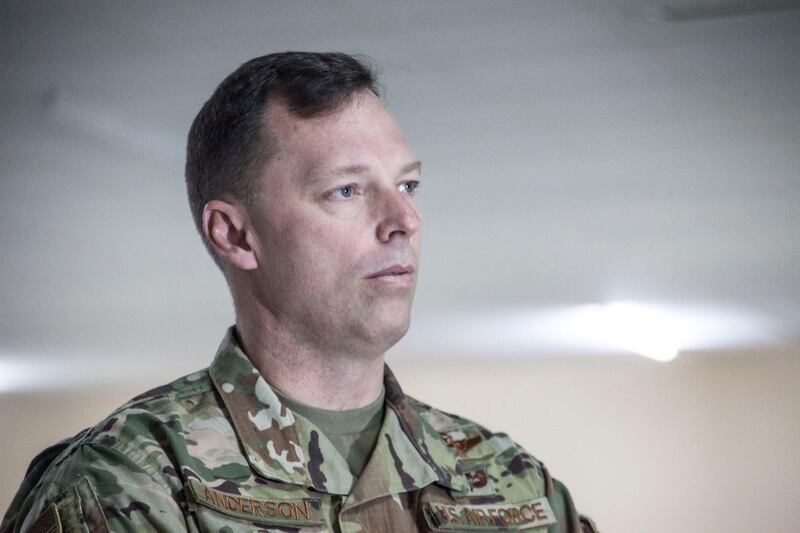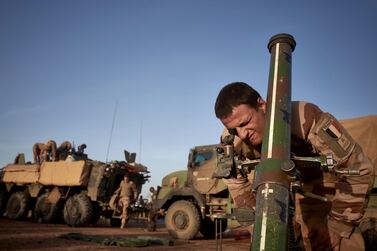Al Qaeda and ISIS-linked fighters are co-operating in West Africa's Sahel region, the only place in the world where this is happening, says the commander of US special forces in Africa.
"I believe that if it's left unchecked it could very easily develop into a great threat to the West and the United States,” US Air Force Brig Gen Dagvin Anderson said.
The leader of US Special Operations Command Africa spoke of the threat as the Pentagon considers reducing America's military presence in Africa.
Experts have long worried about collaboration between Al Qaeda and ISIS.
While their co-operation in the Sahel is not yet a direct threat to the US or the West, “it’s very destabilising to the region”, Brig Anderson said.
He was speaking at the US military's annual counter-terrorism exercise in West Africa, the most active region for extremists on the continent.
The alarming new collaboration in the Sahel between affiliates of Al Qaeda and ISIS is a result of ethnic ties in the region, which includes Mali, Niger and Burkina Faso.

"Whereas in other parts of the world they have different objectives and a different point of view that tends to bring ISIS and Al Qaeda into conflict, here they’re able to overcome that and work for a common purpose,” Brig Anderson said.
It allows the extremist groups to appeal to a wider audience in a largely rural region where government presence is sparse and frustration with unemployment is high.
The past year has seen a surge in deadly violence in the Sahel, with more than 2,600 people killed and more than 500,000 displaced in Burkina Faso.
Al Qaeda is the bigger threat in the region and globally, Brig Anderson said.
“[ISIS] is much more aggressive and blunt, and so in some ways they appear to be the greater threat,” he said.
But Al Qaeda, which continues to quietly expand, is "for us the longer strategic concern”.
Al Qaeda has been successful at consolidating in northern Mali and moving south into more populated areas, “and taking various groups and galvanising them together into a coherent movement”, Brig Anderson said.
The most prominent of those affiliates is a coalition of Al Qaeda-linked groups known as Jamaat Nasr Al Islam wal Muslimin, with about 2,000 fighters in the region, the Centre for Strategic and International Studies says.
West Africa's Sahel, the vast strip of land south of the Sahara Desert, for years has struggled to contain the extremist threat.
In 2012, Al Qaeda-linked fighters seized large parts of northern Mali. French forces pushed them from strongholds in 2013 but the fighters have regrouped and spread south.
The largest ISIS affiliate in the region, IS in the Greater Sahara, emerged more recently and claimed responsibility for killing four US soldiers in Niger in 2017.
The attack led to an outcry in Washington and questions about the US military presence in Africa.
Once peaceful, Burkina Faso has become the latest front for what experts call an alarming rate of deadly attacks.
Al Qaeda affiliates visit areas in advance to “engage with key leaders in key locations to recruit early”, Brig Anderson said. Others move in later.
The fighters fund themselves through kidnapping for ransom as they try to control access to markets through taxes, he said.
They are also probably looking to what has been a source of income for centuries: gold.
“I believe they’d be happy to be able to control some of the artisanal mines and other mines in the area, especially the gold and other precious metals that are easily transportable,” Brig Anderson said.
While Al Qaeda affiliates work toward establishing safe havens, IS in the Greater Sahara wants to destabilise local government, control territory and rally people to its cause, he said.
The strategy for countering the growing threat from the extremist groups is far more complex than just military action, Brig Anderson said.
“There’s no easy answer.”
Many young men in the largely impoverished region feel isolated from the government and are drawn in by extremists' promises of employment and purpose.
“Al Qaeda, whether we agree with it or not, brings some level of justice to many of these areas, and some level of services that aren’t provided by central governments,” Brig Anderson said.
“And they provide some representation to minority groups that don’t feel part of the larger community, such as the Fulani or the Tuareg.”
African partners need to invest in governance, he said, although international involvement is necessary.
The French lead the military effort in the Sahel with more than 5,000 forces and they hope to bring in more European partners.
But France has urged the US to reconsider any cuts to its already small military presence of about 1,400 personnel in West Africa.
The US has about 6,000 personnel on the continent.
Brig Anderson said the US was already doing a lot in the Sahel through the State Department, a large USAid presence and investment.
“Instead of looking at the size of the presence, I think we should look at what is the appropriate engagement across the government, from all levels,” he said.
With very small engagement, the US can still help countries to develop the capabilities to build coalitions and share intelligence, Mr Anderson said.
“It’s going to take all these nations working together, but also it’s going to have to be African solutions to an African problem."






